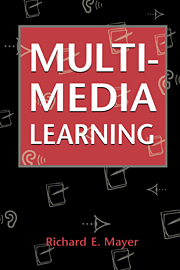Book contents
- Frontmatter
- Contents
- PREFACE
- 1 The Promise of Multimedia Learning
- 2 Multimedia Instructional Messages
- 3 A Cognitive Theory of Multimedia Learning
- 4 Multimedia Principle
- 5 Spatial Contiguity Principle
- 6 Temporal Contiguity Principle
- 7 Coherence Principle
- 8 Modality Principle
- 9 Redundancy Principle
- 10 Individual Differences Principle
- 11 Principles of Multimedia Design
- REFERENCES
- AUTHOR INDEX
- SUBJECT INDEX
7 - Coherence Principle
- Frontmatter
- Contents
- PREFACE
- 1 The Promise of Multimedia Learning
- 2 Multimedia Instructional Messages
- 3 A Cognitive Theory of Multimedia Learning
- 4 Multimedia Principle
- 5 Spatial Contiguity Principle
- 6 Temporal Contiguity Principle
- 7 Coherence Principle
- 8 Modality Principle
- 9 Redundancy Principle
- 10 Individual Differences Principle
- 11 Principles of Multimedia Design
- REFERENCES
- AUTHOR INDEX
- SUBJECT INDEX
Summary
Coherence Principle: Students learn better when extraneous material is excluded rather than included. The coherence principle can be broken into three complementary versions: (1) student learning is hurt when interesting but irrelevant words and pictures are added to a multimedia presentation; (2) student learning is hurt when interesting but irrelevant sounds and music are added to a multimedia presentation; and (3) student learning is improved when unneeded words are eliminated from a multimedia presentation. Each version of the coherence principle is addressed in turn in this chapter.
Theoretical Rationale: Extraneous material competes for cognitive resources in working memory and can divert attention from the important material, can disrupt the process of organizing the material, and can prime the learner to organize the material around an inappropriate theme.
Empirical Rationale: In eleven of eleven tests, learners who received concise multimedia presentations performed better on tests of retention than did learners who received multimedia messages that contained extraneous material. In eleven of eleven tests, learners who received concise multimedia presentations performed better on tests of transfer than did learners who received multimedia messages that contained extraneous material.
All of the materials we used in our research provide cause-and-effect explanations of how scientific systems work in which a change in one part of the system is logically related to a change in another part, and so on. Coherence refers to the structural relations among elements in a message, such as the cause-and-effect chain in our explanations.
- Type
- Chapter
- Information
- Multimedia Learning , pp. 113 - 133Publisher: Cambridge University PressPrint publication year: 2001



